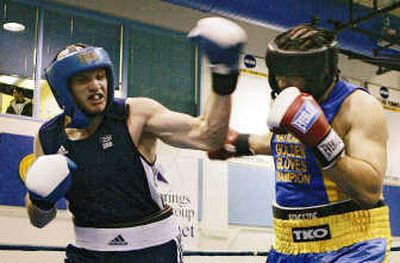The future of fighting

COLORADO SPRINGS, Colo. – On his long road that he hopes will lead to Beijing next summer, super-heavyweight boxer Mike Wilson constantly hears friends and fans tell him that his is a dying sport and the real future of fighting is in the wildly popular mixed martial arts.
His response is spread across his chest on a tattered T-shirt:
“Real men fight in the ring. Cages are for the zoo.”
It’s a sentiment shared by many of America’s best amateur boxers who gathered in Colorado Springs recently for the national championships and will compete in the Olympic box-offs next month for a spot in the 2008 Games.
That’s not surprising. These fighters have spent their lives throwing fists, not elbows, and using their footwork to avoid getting hit, not stomping on somebody’s face.
They don’t have a ground game to speak of and would have to develop takedown and submission moves to catch up with those who got their start in wrestling or judo or jujitsu.
The premiere USA boxer, Olympic flyweight Rau’shee Warren of Cincinnati, said he watches MMA fights “but I’m not a fan. I probably just watch the heavyweights knock people out, that’s about it.”
Others say they’re big fans of MMA and one, bantamweight Gary Russell Jr. of Capitol Heights, Md., said he’d love to make the move to mixed martial arts after his boxing career is over.
Light heavyweight Christopher Downs, a 32-year-old soldier from Fort Carson and the oldest boxer in the running for a spot on the Olympic team, said he admires cage fighters but doesn’t want to be one.
“I’m not knocking UFC, but that’s not something I would want to do. That’s a whole different type of person,” he said. “Their methods are self-defense methods and quick strikes to demobilize a human being, and that’s a real dangerous sport. But these guys are in great shape and tremendous athletes in their own right and different strokes for different folks. This is one of those extreme sports. You’ve just got to love it or love to hate it.”
Wilson, of Central Point, Ore., who won three national championships and was edged by 18-year-old Michael Hunter of Las Vegas for the crown this year, despises it.
“It’s gotten so popular back home where I live and it’s just like everybody, ‘Oh, I’m a cage fighter. I’m a cage fighter.’ And I’m like, ‘If you’re a real fighter, I want to see your butt up at 6 in the morning, putting in road work.’ I mean, all these guys train and go to a gym once or twice a month and call themselves cage fighters,” Wilson said. “Boxing, you’ve got to be in top physical condition, mental condition. There’s just so much more to it. It’s an art. It’s like a fine art. It’s a chess match. It’s a thinking man’s game.”
Paul Wade, co-owner of 3rd Street Boxing Gym in San Francisco, where he trained 106-pound female national runner-up Melissa McMorrow, said he put in a cage next to the ring in his gym because the future of fighting is in MMA.
“We have a mixed martial arts program which offers boxing, jujitsu, wrestling and kickboxing for men and women,” said Wade, who isn’t surprised that many boxers want nothing to do with cage fighting.
Wade said he gets more wrestlers and martial artists interested in cage fighting than boxers.
“I’ll be honest with you, my experience with the boxers, they’re pretty intimidated by getting kicked in the head, someone sitting on their chest and punching them in the face. That’s crazy. Boxing is a way more dangerous sport than MMA, just as far as the impact on the head,” Wade said.
“You get a couple of hundred punches in the head in one fight. In MMA, it’s a lot smaller gloves. That’s one of the things the boxers are intimidated by. But the thing about having smaller gloves – guys get dropped easier and they get knocked out. In boxing, you get a standing eight-count. The repeated blows are not good.”
Despite pro boxing’s slide in popularity, Wilson said he believes the sport is healthy based on the bout that netted Oscar De La Hoya $45 million and Mayweather $20 million two months ago.
“There ain’t nobody in cage fights getting paid like that,” Wilson said.
Wade argues that the Mayweather-De La Hoya fight only proves his point that mixed martial arts is where it’s at.
“I compare the MMA fighters of today to the boxers of the ‘20s, ‘30s, ‘40s, ‘50s and ‘60s, where guys stood there and fought,” Wade said. “These days, you’ve got fighters like Roy Jones, people like Floyd Mayweather Jr., Bernard Hopkins, who are very slick, smart fighters. They’re not going to get hit, which is very intelligent. You’re going to have a good career and also when your career’s over, you’re going to have a brain on your shoulders, you’re not going to be damaged too badly.”
The problem with hit-and-don’t-get-hit philosophy is that it’s not exciting theater, Wade said.
“De La Hoya-Mayweather I thought was a boring fight and a lot of people did,” Wade said. “I find with the MMA, a lot of guys are fighting for very cheap money, but are putting on a hell of a show, you know?”